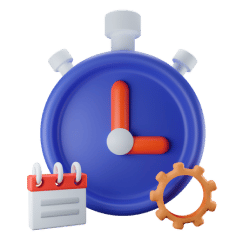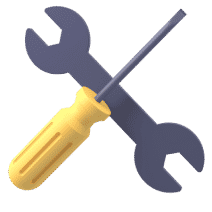Cloud AutoML
Simply feed us your data and we will train dozens of models to find the most accurate one. Our no-code API works from any Python file or notebook.
ML The Old Way
AutoML Workflow
DATA AQUISITION
AUTOML:
Data Prep, Features, Models, HPO, etc.
PREDICTIONS
The workflow steps in AutoML are the same as what you would normally do, but all of this is run automatically on our server so you don't have to deal with it. We try thousands of different methods to increase your model's accuracy. And if you want, you can still create new features and new ways to preprocess the data before you send it to us. AutoML is a tool for you to use however you think is best.
What We Offer
What most programmers simply need is a way to do what they are already doing, but faster and more efficiently. That is what we offer. We help you focus on discovering ways to make a better model instead of spending time just getting everything set up and working properly. Our AutoML system starts by generating an exploratory data analysis (EDA) report, and then handles gruntwork like imputing empty rows, smoothing outliers, data balancing, one-hot encoding, normalization, scaling, data augmentation, feature generation, and feature selection. Next, it trains dozens of models in parallel. Each model is created on a separate server, meaning it can train 100 models in the same time it would normally take you to train 1. When that is complete, it generates an accuracy report and sends you the config and weights files for the winning model.
Tabular Data
Scikit-learn (Logistic Regression, Gradient Boosting, Decision Tree, Random Forest, LDA, KNN, GaussianNB, MLP, Extra Trees, SGD, Ridge, AdaBoost, etc.), XGBoost, LightGBM, CatBoost, and various neural networks. Plus ensemble techniques like Voting, Bagging, Blending, and Stacking. We even run other AutoML programs such as Auto-Sklearn, TPOT, AutoGluon, PyCaret, EvalML, AutoKeras, Fedot, HyperGBM, Auto-PyTorch, MLBox, DeepTables, FLAML, AutoTabular, and MLJar.
Time Series
FB Prophet, AutoARIMA, LSTM, GRU, ETS, SES, TSB, MSES, Sarima, Anomoly Detection, N-HiTS, Shapelets, ES-RNN, N-BEATS, Autoformer, Informer, and Transformer.
Object Detection
YOLO, RetinaNet, EfficientDet, DETR, Faster R-CNN, SSD, CenterNet, FoveaBox, RPN, FCOS, Mask R-CNN, DDOD, CornerNet, Deformable Convolution, CARAFE, Instaboost, Libra R-CNN, SOLO, Guided Anchoring, RepPoints, FreeAnchor, Grid R-CNN, GHM, GCNet, HRNet, NAS-FPN, ATSS, FSAF, RegNetX, Res2Net, GRoIE, Dynamic R-CNN, PointRend, DetectoRS, PAA, SABL, CentripetalNet, ResNeSt, AutoAssign, PVT, PanopticFPN, MaskFormer, DyHead, and a few others.
Image Classification
EfficientDet, MobileNet, ResNet, Vision Transformer (ViT), Inception, Densenet, FBNet, Swin Transformer, Xception, TinyNet, Botnet, Volo, ResNext, GhostNet, Twins, Wide ResNet, VGG, Darknet, Deit, DLA, Halonet, NFNet, ResNEST, HardcoreNAS, Mixer, MNASNet, PNASNet, ResMLP, and many more.
Model Deployment
In the end, building a great model is useless if you can't deploy it, so we make that easier too. After you download the model from our API, you can do whatever you want with it, but as part of our AutoML process, we create a model serving API endpoint for you to use. You can either access it to show an impressive demo of the model to your client, or your client can use the endpoint for real in production.
How To Access Our API
Our AutoML API is not open to the public yet, but if you would like us to create a free ML model for you, email us at eric@impulsecorp.com.
Frequently Asked Questions
One way to get started with AutoML would be to download an open-source program such as TPOT. But it will be slow to use on your PC/laptop. Running on multiple servers would be more practical, but most AutoML software is not made to connect to the cloud. Amazon, Google, and Microsoft offer cloud computing directly of course, but that is not AutoML, and even for a data scientist it can be difficult and time-consuming to take advantage of what these companies offer. An alternative is to use one of the many no-code ML sites. Their focus is on MLOps (keeping track of experiments, working in teams, data versioning, pipelines, model deployment, scaling, etc.) and giving you a nice interface that guides you through the process.
The downside is that you need to spend time learning how their platform works and the fees can be hundreds of dollars a month. Some of these services include H2O Driverless AI, Valohai.com, DataRobot.com, Spell.ml, Obviously.ai, Hasty.ai, Symon.ai, Clarifai.com, Pachyderm.com, and Akkio.com.
If you don't want to completely change the way you do ML, we have a solution. Let us handle some of the work.
Here's a story for you: Kaggle had a machine learning competition a few years ago that involved identifying whales in photos. The initial entries obtained around 30% accuracy. After a few weeks, some entrants came up with new methods to reach 50% accuracy. By the end of the contest, after reading the tips shared in the forum, almost everybody was getting over 80%.
Very little of this increase was due to the usual stuff like testing multiple algorithms, HPO, or transforming data. And using MLOps was not the reason either. It was almost all from trying different approaches most people didn't originally know about or take the time to test. Experimenting over and over again until it showed improvements was the key.
On Kaggle this was accomplished by having 1,000 experts collaborate on a model for months. But if you work by yourself or with a small team, that level of effort is not practical. It can only be achieved through automation.What most programmers really need is simply a way to do what they are already doing, but faster and more efficiently.
That is what we offer. Our service lets you focus on discovering ways to make a better model instead of spending time just getting everything set up and working properly.
The purpose of AutoML is not to replace a data scientist or consultant, it is to help them.
That is why we offer AutoML as an API. Based on our 10+ years of experience working with hundreds of machine learning practitioners, we have found it is best to let programmers do things their own way instead of having them switch to a new platform.
We are working on adding support for Object Tracking (over multiple video frames), Image Segmentation, Pose/Face/Hand/Eye Detection and Tracking, NLP (Natural Language Processing), OCR (image to text conversion), Video Understanding (action detection and recognition), Generative Models (GANs and text-to-image), Self-Supervised Learning, Model Compression (pruning, knowledge distillation, and quantization), 3D Object Detection, GNNs (Graph Neural Networks), Hair Segmentation (for recoloring), and Meta Learning (few-shot learning).


